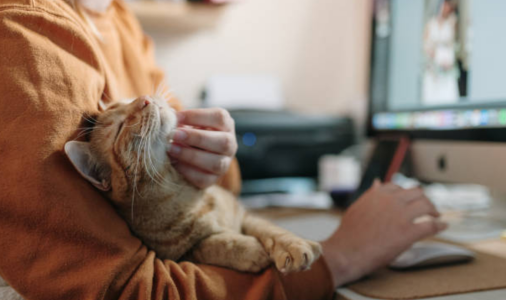Australians Beware: The 'Big Threat' Lurking in Your State That's Sparking Outrage for Immediate Rule Changes!
By
Gian T
- Replies 26
A silent predator roams in the land down under, where the wildlife is as diverse as it is unique. It's not the crocodile or the snake that's causing a stir, but a much-loved household pet: the domestic cat. A recent call for a 'cultural shift' in one Australian state has highlighted a growing concern over the impact of free-roaming felines on native wildlife, sparking a heated debate and calls for major rule changes.
The issue was brought to the forefront during a parliamentary committee hearing, where the Invasive Species Council's Jack Gough made a compelling case for addressing the 'destructive myth' that pet cats are harmless to the environment. The statistics are alarming: an estimated average pet cat kills 110 native animals each year, which translates to a staggering 320 million across Australia, not including the countless frogs and insects that also fall victim.
This isn't just about numbers; it's about the survival of Australia's precious biodiversity. Cats are directly responsible for the third highest number of extinctions in the country, surpassed only by humans and the chytrid fungus. According to Gough, the solution lies in enforceable rules similar to those in Victoria, where regional governments have the power to legislate 24-hour cat containment to protect native wildlife.
The debate over cat containment is far from black and white. Committee chair Emma Hurst and the Animal Justice Party advocate for a balanced approach considering the welfare of cats and wildlife. Hurst emphasises the importance of massive desexing programs to manage overpopulated towns with homeless cats, which she believes will significantly protect wildlife.
Dr Sarah Legge, representing the Biodiversity Council of Australia, supports the goal of cat containment for the benefit of wildlife and the cats themselves. Indoor cats face fewer dangers from traffic, dogs, and diseases. However, she dismisses cat curfews as ineffective, as they merely change the type of animals cats can prey upon.
Dr Colin Salter from WIRES points out that while cats are a problem, habitat destruction and fragmentation pose much greater threats to wildlife. He cautions against using the cat issue to distract from these larger environmental challenges. WIRES advocates for legislative changes that empower local governments to run more effective programs. However, Salter stresses the importance of ensuring that new measures do not unfairly impact certain community members, such as apartment dwellers or renters.
The original article's author, Michael Dahlstrom, brings a personal perspective to the issue, having spent seven years rescuing native birds maimed by pet cats. His experience underscores the real and present danger that free-roaming cats pose to Australia's wildlife.
As Australians, we pride ourselves on our rich and diverse natural heritage. The question now is how we balance our love for our furry companions with the responsibility to protect the unique creatures that call Australia home. It's a complex issue that requires thoughtful discussion, community engagement, and a willingness to adapt our behaviours for the greater good of our wild world.

We at the Seniors Discount Club invite you to weigh in on this pressing issue. Have you experienced the impact of roaming cats on local wildlife? What are your thoughts on cat containment and the proposed rule changes? Share your stories and opinions in the comments below, and let's work together to find a solution that safeguards our beloved Australian fauna.
The issue was brought to the forefront during a parliamentary committee hearing, where the Invasive Species Council's Jack Gough made a compelling case for addressing the 'destructive myth' that pet cats are harmless to the environment. The statistics are alarming: an estimated average pet cat kills 110 native animals each year, which translates to a staggering 320 million across Australia, not including the countless frogs and insects that also fall victim.
This isn't just about numbers; it's about the survival of Australia's precious biodiversity. Cats are directly responsible for the third highest number of extinctions in the country, surpassed only by humans and the chytrid fungus. According to Gough, the solution lies in enforceable rules similar to those in Victoria, where regional governments have the power to legislate 24-hour cat containment to protect native wildlife.
The debate over cat containment is far from black and white. Committee chair Emma Hurst and the Animal Justice Party advocate for a balanced approach considering the welfare of cats and wildlife. Hurst emphasises the importance of massive desexing programs to manage overpopulated towns with homeless cats, which she believes will significantly protect wildlife.
Dr Sarah Legge, representing the Biodiversity Council of Australia, supports the goal of cat containment for the benefit of wildlife and the cats themselves. Indoor cats face fewer dangers from traffic, dogs, and diseases. However, she dismisses cat curfews as ineffective, as they merely change the type of animals cats can prey upon.
Dr Colin Salter from WIRES points out that while cats are a problem, habitat destruction and fragmentation pose much greater threats to wildlife. He cautions against using the cat issue to distract from these larger environmental challenges. WIRES advocates for legislative changes that empower local governments to run more effective programs. However, Salter stresses the importance of ensuring that new measures do not unfairly impact certain community members, such as apartment dwellers or renters.
The original article's author, Michael Dahlstrom, brings a personal perspective to the issue, having spent seven years rescuing native birds maimed by pet cats. His experience underscores the real and present danger that free-roaming cats pose to Australia's wildlife.
As Australians, we pride ourselves on our rich and diverse natural heritage. The question now is how we balance our love for our furry companions with the responsibility to protect the unique creatures that call Australia home. It's a complex issue that requires thoughtful discussion, community engagement, and a willingness to adapt our behaviours for the greater good of our wild world.
Key Takeaways
- A parliamentary committee in New South Wales is hearing arguments on managing cat populations due to their impact on wildlife, with statistics estimating an average pet cat kills 110 native animals each year.
- The Invasive Species Council advocates for enforceable rules and education to contain cats and protect wildlife, looking to Victoria's regional laws for inspiration.
- Debate continues over the most humane and effective methods to balance the welfare of cats with the protection of wildlife, with suggestions including massive desexing programs.
- Experts argue that while cat containment is beneficial, it should be part of a broader strategy that includes habitat preservation, and considerations should be made for the impact on different community groups.








